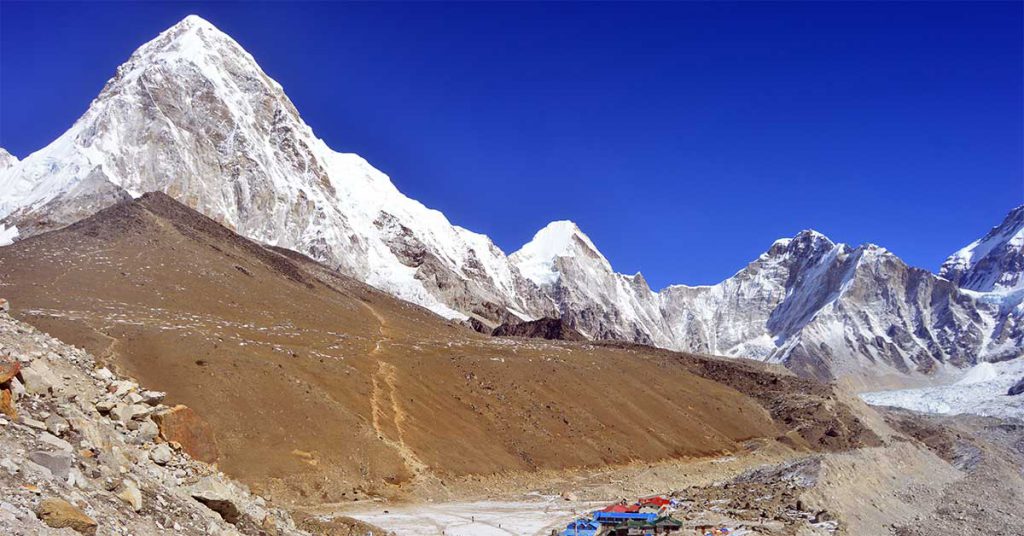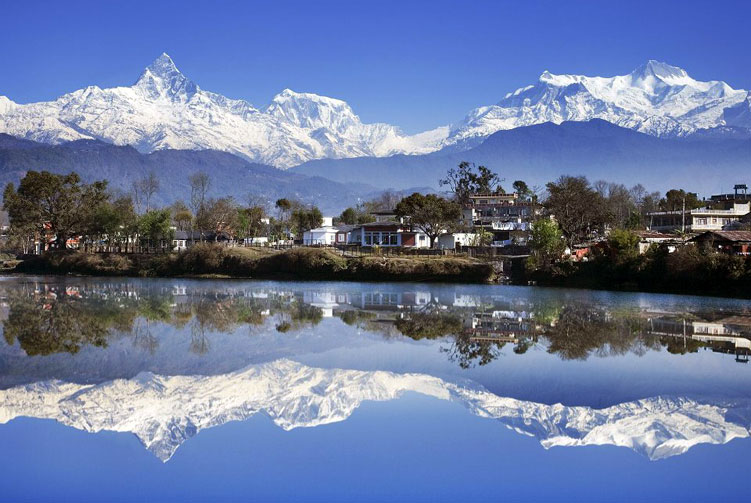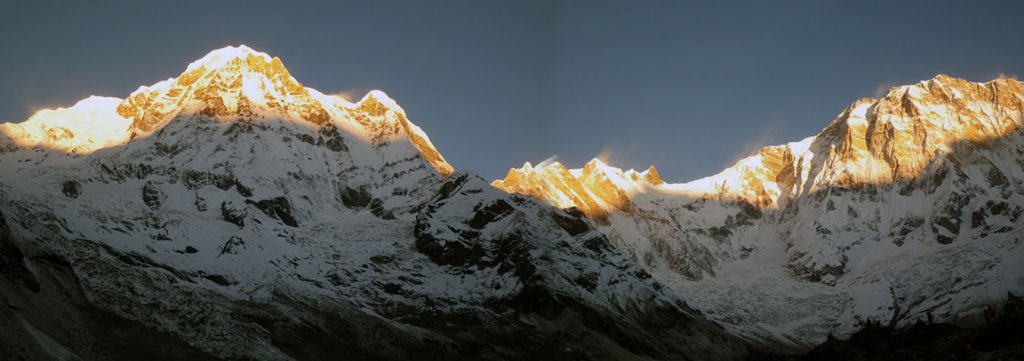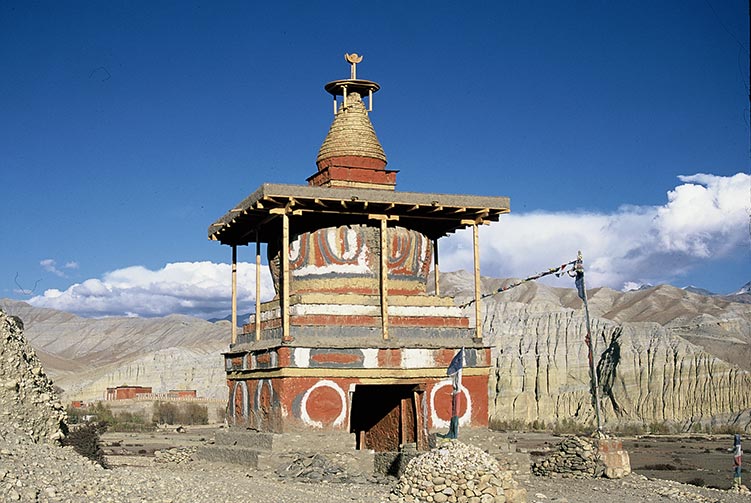As this mountain involves less technical aspects of climbing, many adventure trekkers attempt to summit this beautiful peak every year. No previous climbing experience is necessary to climb this peak however if you have it, you are on more advantageous side. One of the trekking peaks in the Everest region, Lobuche East, at the elevation of 6,119 meters above sea level, has breathtaking views of Mt. Everest, Lhotse, Nuptse, Pumori and Ama Dablam including many other mountains in the region.
Overview
Apart from climbing Lobuche peak, this trip takes you to experience the joy of being at the Everest base camp, the base of the highest mountain in the world. You can also enjoy the panoramic views for Kalapatthar view point, a different view of the Everest and other mountains than from the Lobuche East. This trip is suitable for any fit person with adventure bug and wants to experience it in the incredible mountains.
Trip Highlights
- Cultural Sightseeing tour of Kathmandu
- You'll be surrounded by stunning Himalayan landscapes, with towering peaks and glaciers.
- It's an exciting and challenging adventure, suitable for those with some climbing experience.
- You'll get to immerse yourself in the unique Sherpa culture of the Everest region.
- You'll trek to Everest Base Camp, a famous spot for trekkers and climbers.
- Reaching the summit of Lobuche East Peak (6,119m) at over 20,000 feet is a major accomplishment.
Itinerary
Today is the day of your arrival in Kathmandu, Nepal. As soon as you come out of the Kathmandu airport, you will find our representative waiting for you in the waiting area right outside the arrival lounge. You will be warmly greeted and welcomed by the representative and led to the vehicle. Our vehicle will take you to the trip hotel, most of the time in Thamel, that is 20-30 minutes drive, depending upon traffic, from the airport.
Enjoy your breakfast at the hotel. We come to take your for a wonderful cultural heritage tour of Kathmandu valley. As part of the tour, we are going to visit four of the UNESCO Heritage monuments in Kathmandu valley. The places we visit today are incredible mixture of culture, history, spirituality, art and stories. Overnight in Hotel.
Swoyambhunath
Believed to have been created on its own, this Budhhist stupa is the oldest of all the monuments in Kathmandu valley. Standing atop a small hillock, Swoyambunath, known as monkey temple amongst tourists, provides a fascinating view of the valley, surrounding hills and snow-capped mountain at the distance on a clear day.
Patan Durbar Square
One of the three medieval palace squares, Patan Durbar Square holds its medieval art and architectural grandeur. Amazing skill of the artisans is evident in each and every building that stands in the square. The square comprises of medieval palace, temples and museum.
Pashupatinath
This site is the most sacred Hindu temple area in the country. But, as the temple is strictly a Hindu only area, non-Hindu tourists go there to watch the unique Hindu cremation rituals on the bank of River Bagmati. The death rites of Hindu family there are so engrossing and heart-touching which make you feel the moment. It’s not any kind of intrusion in being there and watching somebody being cremated in an open ground. It’s a great cultural experience.
Boudhanath
This giant Buddhist stupa is considered as the biggest one in the world. This small square with giant shrine has a powerful presence of the spiritual vibrations. It’s an important pilgrimage site for the people following Tibetan Buddhism.
After a day of wonderful immersion into Kathmandu vibes, we are ready to fly and trek into the higher elevation. We drive to airport early morning to board our flight to Lukla to enter the Everest region. About half hour of spectacular flight takes us to the small but beautiful town of Lukla where magical mountain peaks extend their warm welcome to us.
Once we prepare for the day walk, we proceed walking towards Phakding as the destination for the day. The first day of walk in the Everest region goes along the Dudh Koshi River passing through several mani walls, chhortens and beautiful landscapes. Phakding village lies beautifully on the bank of Dudh Koshi River where we spend the night. Overnight in Lodge.
It’s a beautiful day of walking into the Sagarmatha National Park. We relish the mouthwatering breakfast as a gentle breeze comforts the morning. We set off on the trek for the day and reach Monjo to enter the national park zone. After checking into the park, we head up towards Namche Bazar. Crossing suspension bridges over the river in several places; passing through forested parts and many wonderful views, we finally reach Namche Bazar. Namche Bazar is a beautiful settlement on a mountain slope with the view of Himalayan peaks right in front. It is also an important trade center in Everest region. Overnight in Lodge.
An additional day of exploring around Namche is required to acclimatize with the thinning air as we go higher. We hike to the Everest view point to get the very first glimpse of Mt. Everest along with other impressive peaks in the region. We can hike up to Khumjung if you like to. The hiking to a higher elevation will help us acclimatize properly so that we can walk further higher. We return back to Namche Bazar in the afternoon and wander around the bazar. A relaxing afternoon will reenergize and prepare us for the next day. Overnight in Lodge.
A fresh morning with the view of mountain peaks makes our breakfast even tastier. Filled with the energy, we are ready to trek to Phortse village today. Our trek goes to Phortse village via Mong La and Phortse Tenga. Phortse village is a beautiful Sherpa village with agricultural land. We can explore the beauty of the wonderful Sherpa village that nestles on the lap of a mountain.
We leave the comfort of the lodge and head towards Dingboche. The walk passes through the Diboche and Pangboche villages. Pangboche village has a beautiful monastery that is the largest one in the area and has a scalp of Yeti. After exploring the monastery, we take the trail towards Dingboche.
Dingboche is a beautiful Sherpa village that stands at the elevation of 4,410 meters above sea level and projects an incredible view of the mountain peaks. This village is a common stopover place for the trekkers and climbers to Everest Base Camp, Ama Dablam and Island Peak. Overnight in Lodge.
At the elevation of 4,410 meters above sea level here and much higher to go, we are in need of an additional day to acclimatize. For the purpose, we go for a day hiking trip to a higher point near and around Dingboche. The day will bring us breathtaking views of the Himalayan peaks. We return back to Dingboche from the hike and go to explore the surrounding for a while. Overnight in Lodge.
At the elevation of 4,410 meters above sea level here and much higher to go, we are in need of an additional day to acclimatize. For the purpose, we go for a day hiking trip to a higher point near and around Dingboche. The day will bring us breathtaking views of the Himalayan peaks. We return back to Dingboche from the hike and go to explore the surrounding for a while. Overnight in Lodge.
Today is the day when we make it to the destination of this epic journey. We trek to the Everest base camp via Gorakshep after stopping for the lunch there. Gorakshep serves as our overnight site for the day. After checking in the lodge at Gorakshep, we set off on the journey to the epic Everest base camp. The trail to the base of the highest mountain in the world is full of glacial moraine and boulders. We reach the base camp and spend some wonderful time there taking pictures and absorbing the mountain vibes.
We, later, walk back to Gorakshep to stay overnight
The hike that we are going to go for this early morning is taking us to the maximum elevation of the trip. When we hike to Kalapatthar for a marvelous sunrise over the panoramic Himalayan range, we will be at the elevation of 5,545 meters above sea level, the highest point on this trek.
We watch the sun rise beautifully over the magnificent mountains; take picture of the mountains and the sunrise and, later on, return back to lodge at Gorakshep for breakfast. Hungrily devouring the breakfast, we fill up ourselves with much needed energy to go back. We are trekking back to Lobuche Peak Base Camp today.
We spend a full day here at the base camp training, discussing and preparing for the summit attempt. Taking a full day to prepare and rest to be ready for the climb is highly essential part of the trip. This full day will allow us ample time to acclimatize and be ready for the summit push tomorrow. We spend overnight today at the base camp.
We get ready for the adventure of climbing Lobuche East Peak right after the middle of the night. The early start allows us to reach the summit before it gets too windy to be there. Some technical sections come along the route but not too difficult to go through. Early morning views of the mountain peaks from the summit let us enjoy the crisp view. We can enjoy the view of marvelous mountains including Mt. Everest, Lhotse, Nuptse, and Ama Dablam. We return back and start descending after enjoying memorable moments at the top. We descend all the way back to the Base Camp to stay overnight.
This day is an extra day to make up any possible delays or obstacles on the summit push. If we do not need this contingency day, we will trek to Pangboche today.
In case of the use of contingency day, we are trekking to Pangboche village. We trek past Chhukung village; cross Imja Khola and then trek up to Pangboche. Once we reach Pangboche, we can laze around exploring the area.
The journey back down to Namche Bazar will be of around six hours. We trek to Tengboche and visit the famous Tengboche monastery before descending to Namche Bazar. Once we reach Namche Bazar, we can take some relaxing stroll around Namche Bazar in the evening or just stay inside the comfort of the lodge. Overnight at a lodge.
The final day of this trek is eventually here today. We walk back to Lukla via Monjo and Phakding along the Dudh Koshi River. A round trip on the Everest Base Camp trail comes to end here. We celebrate the end of the trekking part of the journey and thank our wonderfully amazing supporting crew members for their service and effort to take us to the base camp and back safely. Overnight at a lodge.
We get ready for the flight back to Kathmandu. We board the plane at Lukla airstrip and fly back to Kathmandu. Once we land in Kathmandu airport, we go to hotel and spend the whole day at leisure on our own. Finding relieving massage, good food, souvenir shopping, and wandering around can keep you busy for the day.
A farewell dinner is scheduled for this evening. We will let you know the departure time for dinner once we reach Kathmandu.
This is an additional day in the itinerary to compensate any possible delays on the trekking or cancellation of the flights. We extremely recommend that you have at least 2 extra days after the itinerary days so to maintain any possible delays or cancellation of the flight. If everything goes without any problem, you can utilize those extra days doing some other activities.
The final day of the trip, we drive you to airport for your scheduled flight homebound or other destination. We will pick you up 3 hours prior to your flight schedule.
The Trip Cost Includes
- Welcome/Farewell dinner with cultural program as listed in the itinerary.
- Airport Pick and Drop in Kathmandu by Private vehicle.
- Tourist Standard Hotel Accommodation in Kathmandu in B/B basis.
- Half day guided city tour with world heritage entrance permit as listed in itinerary.
- Private transportation to and from the starting and ending points of the trek.
- Standard Lodge/Guest House accommodation (best available) with twin sharing basis during the trek.
- Accommodation in Tented Camp while on Island Peak Base Camp.
- Full Board Meals (3 Meals a day) while on the trek.
- Island Peak Climbing permits and TIMS Card fees.
- All necessary camping equipments; Tent, Table & Chair for climbing expedition's crew's.
- Professional & highly expertise government licensed holder local Trekking/Climbing Guide.
- 2:1 Ratio porter carrying 30KG.
- All expenses of the staffs (Guides/Porters) that includes Food, Accommodation, Salary, Insurance, Equipment during your travel period.
- All the necessary trekking gear for porters like jacket /trousers, trekking shoes, gloves, shocks, sunglasses etc.
- Friends Adventure Team's Sleeping Bag, Down Jacket, Walking Poles and Duffel Bag, to be return after trip completed.
- Comprehensive First Aid Kit.
- Arrangement of all rescue and evacuation promptly, in Worst Condition
- Island Peak Climbing group climbing gear, climbing rope, snow bars & carabineers etc.
- Trekking Map, Friends Adventure Team's special Souvenir.
- Agency service charge.
The Trip Cost Excludes
- Any packed food/snacks, aerated drinks, energy drinks, mineral water, alcohol, cigarettes, chocolates, nutria-bars.
- All desserts, sweet things like chocolate, cake, pie, pudding.
- Items of personal nature, Laundry Expenses, Tips.
- Clothing, Packing Items or Bags, Personal Medical Kit, Personal Trekking Gears.
- Any additional staff other than specified.
- Medical and Travel Insurance and Emergency rescue by any means of Transportation including Helicopter evacuation if required.
- Rescue, Repatriation, Medicines, Medical Tests and Hospitalization expenses.
- Airfare of international flights.
- Nepal entry visa fee (Visa issuance is easy at the arrival).
- Hot shower and battery charging on the tea houses.
- Any other item not included in "Cost Includes" Section.
Frequently asked Questions
Island Peak Climbing involves reaching the summit of Island Peak, a popular mountain in the Everest region of Nepal.
No, it’s not recommended for beginners. You should have prior trekking and some basic climbing experience.
The best times are spring (April to May) and autumn (September to November) when the weather is most favorable.
Yes, you should get training in essential climbing skills like using ropes and ice axes.
You can rent some equipment locally, but it’s best to bring your personal gear, especially items like well-fitting boots and clothing.
While there are no strict age limits, climbers are generally expected to be in good physical condition. It’s more about fitness than age.
Altitude sickness can occur at high altitudes and can be dangerous. Proper acclimatization, staying hydrated, and following your guide’s advice can help prevent it.
You’ll stay in tea houses or lodges during the trekking portion and eat locally available food. At higher altitudes, the options may be limited.
Climbing Mount Everest is a different and much more challenging endeavor that requires extensive training and permits. Peak climbing trips typically do not include an attempt on
Yes, travel insurance that covers emergency evacuation and medical expenses is essential. Check that it also covers high-altitude activities.
Prioritize cardiovascular fitness, strength training, and endurance exercises. Hiking and trekking in your local area can also help prepare you for the altitude.
The cost can vary depending on the tour operator, the services included, and the duration of the expedition. On average, it can range from a few thousand to several thousand dollars.
Yes, many travelers choose to explore other parts of Nepal, like Kathmandu, Pokhara, or go on other trekking adventures after their peak climbing expedition.
Respect local customs, avoid littering, and use designated trails. Hiring local guides and porters also supports the local economy.
On average, you walk about 4 to 6 hours per day. One or two days can be as less as 3hrs and one or two days can be as long as 7hrs.
Yes, you can charge batteries en route. Charger should be brought. There are hot shower facilities as well. You may have to pay certain amount for both ($1-$2). Negotiate. Also, hot water facility could be free at lower elevation.
No. There are no ATMs on this trek route. You will have to draw enough cash in Kathmandu/Lukla or Namche. There are a number of ATMs in these cities. Everything is paid in Nepali rupees. So money should be exchanged before the start of the trek.
Yes. Internet can be accessed in most places. Sometimes, there might be some technical problems. Internet in Nepal is not as fast as you are used to and at times you can just lose connection.
No, it’s not strictly necessary to hire a guide or trekking agency for Lobuche East Peak Climbing, but it’s highly advisable, especially if you’re not an experienced mountaineer. Guides and agencies provide essential safety, local knowledge, and logistical support. They help with permits, navigation, and emergency situations, making your climb safer and more enjoyable. While it adds to the cost, the benefits of having a guide or agency often outweigh the expense, particularly for your safety and overall experience.
For Everest region, pay for guides range from $20 to $30 per day and porters take $15 to $25 per day.





























